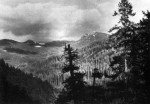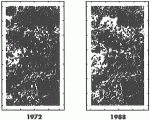Linking Pattern and Process Across Scales
One of the challenges facing each LTER site is how to strike a balance among the various approaches and scales required to address a problem. A central focus of research at H.J. Andrews has been to understand the linkages between structure and process within and across scales, with particular emphasis on system responses to changing climate, to human and natural disturbances, and their interactions. We will describe three examples of research that deal with different scales and interactions among scales.
Linking Terrestrial and Stream C & N Dynamics
If temperatures warm due to global climate change, one would expect decomposition of organic matter to increase; however, to understand the implications of this change a number of questions must be answered. To what degree are levels of soil organic matter (SCM) controlled by temperature? How labile is SCM and what will be the fate of N released as organic stores in soil drops?
To examine the question of temperature control, Tom Bell, Steve Hart and Dave Perry have transferred soils among forests across an elevation gradient equivalent to projected climate change. This experiment indicates that levels of SCM in our montane forests are strongly controlled by temperature. During the first six months of incubation (winter-spring), soil transferred 800 m down in elevation released 270 percent more N to resin bags than controls, while soils transferred from low to high elevation released 85 percent less than controls. Summer-fall incubations produced the same pattern, but the effects of transfer were somewhat less than in winter-spring incubations.
This soil-transfer experiment indicates that soil warming will pulse large amounts of net mineralized N into forest soils in our area. If absorbed by trees, the transfer of N from low C/N humus to high C/N tree tissues may increase productivity, creating a relatively strong sink for atmospheric CO2 and a negative feedback to global warming. N not taken up by trees could be leached to streams, or released to the atmosphere as N2 and N (the latter creating a positive feedback to warming).
Stan Gregory and Gary Lamberti are currently examining the potential effect of N additions to stream productivity and trophic structure. Past studies on NPP suggest that base cations would rather quickly limit tree response to N. To further test this, Maria Gillam, Bob Griffiths, Peter Homan, Dave Perry, Phil Sollins, and Bill Winner have initiated growth chamber studies, funded by the U.S. Department of Energy through WESTGEC, in which C and N fluxes in tree-soil microcosms grown under varying temperature and CO2 regimes will be measured. Results from these experiments and experiments conducted by Ruth Yanai from Cornell will be used to parameterize the TREEGRO model, thereby providing a starting point for modeling regional C and N fluxes associated with climate change.
Linking Landscape Patterns & Processes
A large part of our efforts over the past decade has been devoted to landscape-level issues, including interactions between landscape patterns and processes within local ecosystems. As one example, the proportion of successional stages influences the relative abundance of different animals, which feeds back to affect local food-webs and plant communities. The dramatic shift to early-successional habitat has led to an increase in elk and deer; their numbers are higher now than at any time in recent history. Elk are overgrazing alpine meadows in the Cascades, leading to accelerated erosion, and may be altering site N dynamics by heavy feeding on early successional N-fixing shrubs. On the other hand, spotted owls are old-growth dependent, top predators in a food chain that extends downward to small mammals, fruiting bodies of mycorrhizal fungi, and trees. We are interested in the degree to which reduced numbers of owls might be reflected in populations of small mammals and truffle-producing mycorrhizal fungi.
A key process mediated by landscape patterns is the propagation of disturbances. One idea Gay Bradshaw, Andy Hansen and Dave Perry are currently exploring is that landscapes may either dampen or magnify the spread of a given disturbance. For example, based on historic and recent fire patterns, we have hypothesized that the regional shift in age classes from old to young forests has altered the landscape from a dampening to a magnifying one. If true, this has direct implications for future fire regimes and cumulative impacts on local ecosystems. A future task is to link models of fire spread in different landscape types to our site-level studies of biological legacies and other factors that determine soil stability and resilience of local communities.
Regional Carbon Dynamics
The Pacific Northwest is an important region in which to study carbon dynamics. It contains a large area of extremely high biomass forest ecosystems (500-1500 Mg C/ha), and is currently being converted from a largely old-growth landscape to one of younger, plantation forests. Our initial examination of the effect of this transition involved the development of a stand-level forest model to examine the changes in carbon stores over succession. This analysis indicated considerable carbon efflux (2 Pg) may have resulted from past timber harvest within western Oregon and Washington.
More recently, Warren Cohen, Bill Ferrell, Mark Harmon, Peter Homan, Phil Sollins, and Dave Wallin have started to expand beyond single stands to consider the region as a whole. Remotely sensed imagery is being used to observe where and when forests were harvested and to predict the age structure of forests. Regional temperature and moisture gradients are being used as driving variables for forest and soils models so that carbon stores within forests are a function of climatic variables as well as time since disturbance.
Parameterization and validation of this region model is requiring synthesis of much of the process- and stand-level data collected in past IBP and LTER efforts. Finally, Bill Ferrell, Steve Garman, and Mark Harmon are examining the degree harvesting methods have changed over the last century, so that we may predict how carbon stores in forest products have changed. Our ultimate goal is to integrate the stand age, climatic, and carbon stores models to predict past and future changes of carbon stores within the Pacific Northwest region.
For further information: Mark Harmon or David Perry, Oregon State University, Department of Forest Science, Peavy HaIl 154, Corvallis, OR 97331, 503-750-7333/737-6588.

 Enlarge this image
Enlarge this image

